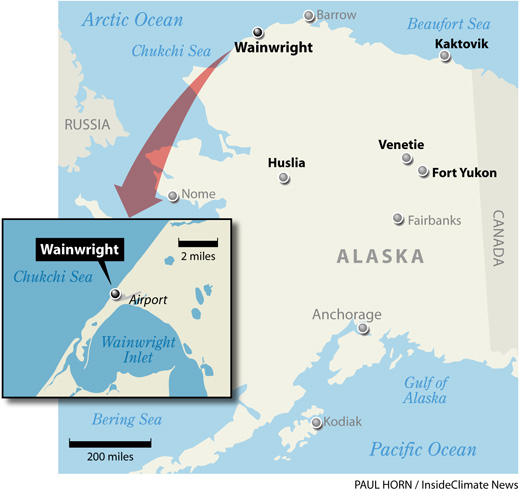Zoomed-In Climate Models Help Alaska Communities Plan for Uncertain Future
Special thanks to InsideClimateNews.org for letting us post this excerpt by Amy Nordrum
Hunters in the Alaskan village of Wainwright, a community of about 550 Inupiat Eskimos at the lip of the Chukchi Sea, have long harvested bowhead whales from the ocean. Each spring, crews of 15-25 hunters set out in umiaqs—boats made from seal skins and caribou sinew. The hunters usually launch from Point Belcher, where the ice cracks open to expose the water in slivers called “leads.” Then the whalers follow these narrow channels to the sea.
They may land whales as long as 55 feet, but a young whale that is as round as it is long—about 30 feet—called a “butterball,” is considered the most succulent. Successful captains share the fresh catch in a big home feast right after the harvest. The rest of the thousands of pounds of meat feeds the villagers through the next winter.
Before the feast, the hunters must heft the dead whale onto a flat piece of shelf ice to butcher it. But climate change is making it tougher for these whalers to find a spot to butcher their catch.
“It’s all about safety and where you can pull up a whale when it’s landed,” said John Hopson Jr., mayor of Wainwright and a whaling captain. Now, the shelf ice breaks up earlier each spring. “What [hunters] have noticed is the ice is thinner than it used to be.”
The risk of falling through, laden with the weight of a whale, makes it too dangerous for hunters to venture out on most days.
Todd Brinkman, a biologist with the University of Alaska Fairbanks, is combining such anecdotal information with global climate models to show communities a future under the influence of climate change. He wants to give a clearer picture to people who are struggling to know, “What will climate change look like to me?” Brinkman has been trying to answer that question for five years, but his work builds on the very first regional climate model developed in 1989 by Robert Dickinson at the National Center for Atmospheric Research.
The urgency for this sort of applied climate science is greatest in Alaska, which has warmed twice as fast as the rest of the country, with an average annual increase of 3 degrees Fahrenheit, according to the most recent National Climate Assessment. That means that many symptoms of climate change—from thawing permafrost to disappearing sea ice and ocean acidification—have already taken hold in the nation’s largest state.
Read the rest at InsideClimateNews.org

Are zoomed in,climate models considered reasonably accurate or just educated guesses? Technology has helped the ag community immensely as far as weather stuff is concerned. There are different hybrids for wet or dry conditions. There are early and late maturing hybrids in case planting is delayed in Spring by cold,wet or even too dry weather.I don’t know beans about whales or whale harvesting. We don’t see many whales in cornfields.